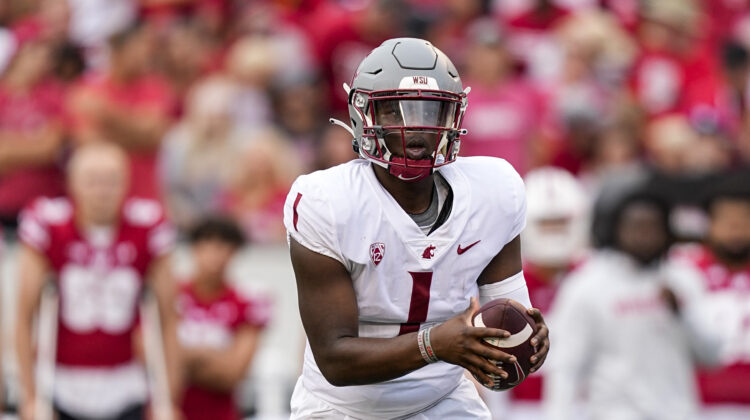Are Oregon State and Washington State joined in holy matrimony, ’til death do them part? If so, what is the best possible outcome for the duo? — @tailgatestate
We’ll step aside and let Oregon State president Jayathi Murthy answer that question herself.
During a news conference Friday (conducted remotely), Murthy was asked about OSU and Washington State acting together following the collapse of the Pac-12.
“We are wonderfully aligned,” she said.
That alignment is both natural and enforced. With their difficult geography, land-grant status and limited resources (relative to Washington and Oregon), the schools are cut from the same model and face many of the same challenges.
And after the Pac-12’s demise, they are alone on the Power Five seas.
Their options are to rebuild the conference — a massive lift but potentially the most prosperous — or enter the Mountain West.
They have no choice but to link arms into the next era.
If Oregon State and Washington State go to the Mountain West, do you see their College Football Playoff chances going up, down or staying the same? — @BennyL1986
Before answering, let me state categorically that the Hotline is not minimizing the impact of the Pac-12’s collapse on the Beavers and Cougars in any way, shape or form.
It’s massively problematic for them on multiple levels and could have a deep impact on their ability to fund sports teams and retain current employment levels within their athletic departments.
But as it pertains only to participating in the College Football Playoff — not an inconsequential factor by any stretch — every plausible future scenario is better for OSU and WSU than if the Pac-12 had remained intact.
Whether they rebuild the conference, execute a reverse merger with the Mountain West or join the Mountain West in a traditional expansion move, the Beavers and Cougars will possess a wider path to the CFP when it expands at the end of next season.
The approved format grants automatic bids to the six highest-ranked conference champions, but that could change as a result of the Pac-12’s implosion.
The SEC and Big Ten want more spots for at-large teams, so expect the number of automatic qualifiers (AQs) to drop to five. But there will only be four power conferences. The CFP format must allow for one more AQ spot than there are power conferences in order to provide access to the rest of the FBS membership and avoid a lawsuit.
It doesn’t matter if WSU and OSU join the Mountain West or reform the Pac-12. The champion of their conference will compete for the final AQ berth against the winners of the Sun Belt, MAC, Conference USA and American, which has lost all its top football schools.
In our view, a rebuilt Pac-12 or enlarged Mountain West would clearly be the best of the non-power conferences. The Beavers and Cougars won’t need 12-1 or 11-2 records; they won’t need top-10 or top-12 rankings. They will simply need to be ranked higher than the champion of the MAC, American, C-USA and Sun Belt.
We believe their prospects for winning the new conference, and winning it with some regularity, are vastly better than their chances of winning an intact Pac-12 that featured Oregon, Washington and Utah.
And we believe their prospects for being the highest-ranked champion outside the SEC, ACC, Big 12 and Big Ten are excellent, so long as the administrations commit the requisite resources.
The expanded playoff will change the sport like nothing before it. In theory, OSU’s Murthy and WSU president Kirk Schulz will recognize that within the carnage is a huge opportunity.
Previously, you cited three options for WSU and OSU, including “rebuild the Pac-12 with teams from the Mountain West.” I am curious about the reasons you did not include a rebuild with “the best of the rest” from the MW and American. — John Lamar
That is an option, but it carries a major obstacle: Exit fees.
We don’t see the American schools as relevant to a rebuild — the geography is poor and the media valuations are low — and any poaching of the Mountain West in time for the 2024 season would require the targeted schools to muster about $34 million in departure fees, which isn’t reasonable.
But if the Cougars and Beavers rebuilt the Pac-12 with the entirety of the Mountain West membership, those schools could simply vote to dissolve their league and move under the Pac-12 banner. Without a conference, there would be no exit fees.
The simplest option for all involved would be a standard expansion move, with OSU and WSU joining the Mountain West. However, it’s quite possible the schools would forfeit tens of millions of dollars in Pac-12 assets — assets they would control if the conference remains a legal entity.
I’ve read that the Big 12 has allegedly stated otherwise, but if the ACC turns down Cal and Stanford, what are the chances of the Big 12 absorbing the Pac-4? — @WHS1969
It’s moot now, but the chances were less than zero and anything you read should have been ignored.
The Big 12 is set with 16 schools and well positioned for the near term.
The reverse merger between Pac-2 and the Mountain West almost makes too much sense. So what do the universities involved think of it, and what are the obstacles to making it happen? — @pfnnewmedia
The universities have yet to reach any conclusions as they attempt to determine the size of Pac-12 assets and liabilities. That process is not for the athletic directors and presidents but, rather, the attorneys and financial officers. And it could take several more weeks.
The Mountain West is watching, too. The stockpile of assets and the value of the Pac-12 brand could be enticing enough to convince the 12 schools that dissolving their conference and moving under the Pac-12 banner is the most lucrative option.
But as you might imagine, that’s a complicated process on multiple levels.
How does a Group of Five conference elevate itself to a Power Five conference? Is it just tradition, or is there a path the new ‘Pac-2’ could take to regain Power Five status? — @BakerMeow
Power Five status is determined by the Power Five conferences, which received that authority through the NCAA legislative process.
Rest assured, the Big Ten, SEC and Big 12 will extend no favors to the ‘Pac-2’ or any Group of Five league, regardless of its composition.
But as mentioned above, the fear of an antitrust lawsuit will force the heavyweights to preserve a playoff path for the Group of Five.
I’ve heard different reports as to how much Oregon and Washington are going to receive in the Big Ten in this media cycle. So what is the true amount? — Kent Pflugrath
We don’t have the exact figure, which is buried in a contract that probably won’t ever enter the public realm.
But the exact figure doesn’t much matter. The schools are receiving roughly 50 percent of the Big Ten’s media shares over the six-year contract cycle — approximately $32.5 million annually, or about $200 million in total.
Whether the actual figure is $183 million or $207 million or whatever, the Huskies and Ducks will be working at an extreme deficit relative to their competition and must find alternate sources of revenue to provide the needed resources to compete for playoff berths.
That’s easier for Oregon thanks to you-know-who.
Why would the UC Regents not mandate that Cal and UCLA be in the same conference by requiring UCLA to leave the Big Ten at the earliest opportunity, unless Cal has been invited to join the conference by such time? — @RajaMuh16021485
The regents made it clear last year that they won’t mandate conference affiliation. They could have forced UCLA to reverse course or insisted that the Bruins only enter the Big Ten alongside Cal.
The decision looks even more significant now than it did at the time.
With the Pac-12’s collapse and the Bears entering the ACC at a reduced revenue share, the regents will seriously consider slapping UCLA with an annual subsidy to support its sister school’s athletic department. (The payment range is as low as $2 million and as high as $10 million.)
In that regard, the Bruins came out much worse for wear from the tumult of the past month.
Whatever they stand to receive from the Big Ten in annual media revenue, plan to remove at least $15 million — about $10 million in increased travel costs and the high end of the subsidy range — to determine the net amount.
If the Big Ten distributes an average of $65 million to its full-share schools over the course of the contract cycle, the Bruins will pocket just $50 million or so.
The two most important things in realignment have been TV market size (not actual viewership) and brand strength. How is “brand” strength measured? — @nickbeatty72
The media companies use a series of metrics to determine the valuation of each football program, including social media following.
But TV ratings — the viewership totals for any given school over the course of years — are critical to the assessment of brand value.
A decade ago, cable TV homes were the driving force behind realignment. The Pac-12 added Colorado because the Denver market brought eyeballs and dollars.
Now, the prime driver of valuation is brand, the ability to generate top-tier ratings. Oregon’s value to Fox and the Big Ten doesn’t reside in the size of the Portland media market (No. 21). Instead, it’s the Ducks’ national brand, which is reflected in their viewership levels over the years.
What does the future hold for the Hotline? Will you soon be the authority on Big XVI, Big 18, Pac-2 and Mountain West teams? — @BauerOnTheMic
The Hotline covers the schools within the Pac-12 footprint and the issues that matter to them, regardless of the conference in which they compete.
For the majority of our existence, we used the ‘College Hotline’ banner — it wasn’t until the late 2010s, in fact, that we adopted the ‘Pac-12 Hotline’ name.
(The conference has not participated in the CFP since we changed names, so maybe it’s us?)
Perhaps we’ll switch to Wilner Hotline, which is my Twitter handle; that detail has yet to be determined.
Regardless, we’ll continue to provide news and analysis of all relevant developments, both on and off the field.
Thanks to everyone for your support and loyalty over the years.
Related posts:

(AP Photo/Darryl Webb)
Pac-12 survival: What’s next for Oregon State, Washington State, Stanford and Cal after mass exodus to Big Ten, Big 12
Oregon State head coach Jonathan Smith, (AP Photo/Ashley Landis)
Mailbag: Playoff path for WSU and OSU, Fox vs. the Bay Area duo, elements of Pac-12 reconstruction, a “60 for 60” and more
Washington State quarterback Cameron Ward (1) (AP Photo/Andy Manis)
Wilner Hotline – Saturday Night Five: Along come the Cougars, OSU’s big win, USC’s takeaways, collecting wins (except in Boulder) Pac-12 chaos: Judge sides with WSU and OSU, brings board business to temporary halt
Pac-12 chaos: Judge sides with WSU and OSU, brings board business to temporary halt


